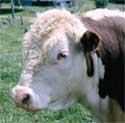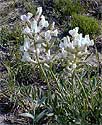 | Locoweed??? |
 | Locoweed??? |
 White Locoweed |
By Ellen Kuwana Neuroscience for Kids Staff Writer February 3, 2004
You may have heard of mad cow disease, also known
as bovine spongiform encephalopathy (BSE). Cows with BSE show symptoms
such as lack of coordination, aggression, seizures, and tremors (shaking).
Cows can get symptoms similar to BSE in another way: by eating locoweed.
Locoweed, named for the Spanish word for "crazy," is a plant of the pea
family that contains the toxin Locoweed is a common perennial plant found throughout the western United States and parts of Mexico. It is a hardy plant that is difficult to control; its seeds can lie dormant for 50 years! Locoweed is poisonous at all stages of growth, and all parts of the plant are toxic. The plant grows in clumps, reaching heights of 30 cm (11.8 inches). Its flowers look similar to sweet pea flowers, and can be blue, purple, yellow or white. There are more than 300 species of locoweed (Astragalus and Oxytropis spp.), most of which are toxic. |
 Purple Locoweed, Photos courtesy of Mike Haddock |
|
Livestock (cattle, horses, sheep, goats) and wildlife (elk, deer,
antelope) eat locoweed in the early spring and late fall. At these times,
locoweed is green, while most other plants are brown. It takes two to
three weeks before symptoms of poisoning appear. The toxin affects the
nervous system and can cause animals to run in circles, drool, stagger and
become aggressive. The animals also act depressed and lethargic (slow,
tired). Chronic exposure to locoweed leaves animals weak, as they lose the
ability to find and eat food. Some of the toxic effects can be reversed;
if the animal is removed from the locoweed-infested area, some of the
symptoms disappear. Some neurological damage, however, is permanent, as a
"locoed" animal will behave unpredictably in the future. Acute cases occur when an animal's diet is composed of 10-15% locoweed. Scientists do not know how low levels of locoweed consumption affect animals, although they theorize that the animals' immune and reproductive systems are adversely affected. There is no known treatment for locoweed poisoning; ranchers and farmers can spray locoweed with herbicides to control its growth and spread. Surprisingly, toxins can be put to use in human medicine. Just as the botulism toxin (Botox) has been applied to treat wrinkles and to cure migraines, some studies suggest that swainsonine and related plant toxins may have useful application in fighting cancer. |
|
References and Additional Resources:
|
| BACK TO: | Neuroscience in the News | Exploring the Nervous System | Table of Contents |
![[email]](./gif/menue.gif) Send E-mail |
 Get Newsletter |
 Search Pages |